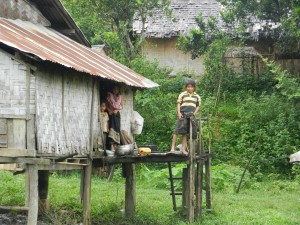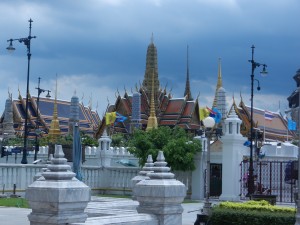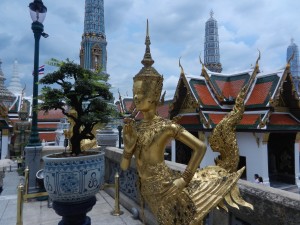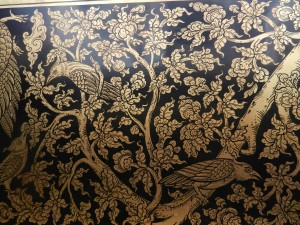Most archeologists and linguists believe that Thais originated in southern China. As their populations rose and as the Qin and Han Dynasties expanded into the Yangtze area, Thai groups spread out from Vietnam to northeastern India. So Thai cultures became very widespread.
There are still Thai-speaking groups in many countries outside Thailand. But this great culture isn’t usually taught in schools. One of the reasons is it’s hard to get a handle on. Its people thought in different ways than they have in better known civilizations like China and India. But Thai cultures encompasses such a wide area, are very rich, and still thrive. So we’ll venture into their ancient roots.
Ancient Thais unified their world in a different way than Chinese and Indians have. A key concept was muang. It has had so many meanings that the historian David Wyatt warns that it’s hard to translate.
One of its meanings was in relation to the village, the ban. A muang referred to a larger territory which encompassed a cluster of villages. The bans within it formed a unit that pooled resources for common defense. The most important ban in the area acted as a hub for trading, defense and rituals.
But the meaning of muang was personal as much as geographic. The head of the most important family in the central ban often acted as the headman, and he erected a pillar outside of his house which people treated as the axis of supernatural powers. He could distribute them throughout his territory with rituals. For his protection, people owed him tribute in the form of rice, handcrafts and labor.
People still honor the city pillar in modern Thailand–Bangkok’s presides across from the Grand Palace, and many locals pay their respects, like the ones in the above photo.
People still conduct rituals there. The above musicians accompanied a dance performance.
So the term muang has referred to several things at the same time:
1. A hub village which was above the nearby ones in a hierarchy.
2. The area encompassing all villages with common defenses and rituals.
3. The headman over all the villages.
4. The supernatural power of the land that the villages called home–its power to generate life (like rice growing) and, the nature spirits and human ancestors that hung around it.
5. A safety zone which everyone under the headman’s protection shares. It’s traditionally distinguished from the surrounding forests and mountains, which are full of untamed energies, and bandits and wild animals.
The word muang doesn’t fit Westerrn, Chinese or Indian categories–it’s a key ancient Thai concept which has to be understood in its terms, but what a rich range of terms!
The world of the muang seems to have had many contraries. It was both intimate and full of nature’s awesome power. It was a unified territory, but pluralistic–profuse with spirits and ancestors. There was no one god, like Yahweh or Allah, who towered over all creation and directed it from the top-down. Nature had an abundance of life forms and spirts that were embedded with each other.
And muangs were flexible–people were relatively free to conduct their local affairs as long as they paid tribute and contributed their muscles if their was a war. They also moved to a different muang if its headman showed more power than their current one.
Thai domestic architecture made moves relatively easy. Stilt homes could be taken apart, moved and reassembled.
Ancient China was different. From the Shang Dynasty on, a royal court centralized human life as the hub of economic exchange and of rituals. It also centralized the spirit world. But the Thai world was pluralistic–many muangs coexisted, and they expanded and contracted as leaders’ power waxed and waned.
Ancient Greece was also different. The city-state was associated with a more permanent land area–a topos. The Greek world was partitioned into several distince places, whose identities remained stable as long as someone else didn’t invade and colonize them.
A lot of Thai art forms express this world, which is abundantly and joyfully pluralistic on one hand, and unified in a social hierarchy and in an embedded natural environment on the other. Bangkok’s Grand Palace (above and below) projects both an irreducible variety of forms and the royal family’s power to unify Thailand.
You can wander around the Grand Palace and never exhaust the blends of forms and colors, but the whole landscape is under the grace of the King and the Buddha.
Many small-scale art forms in Thailand have the ancient muang’s combination of profuse energies and charming intimacy–the birds in the above scene are great touches. Nothing shows this blend better than the Buddha’s footprints at Wat Pho.
The term muang wouldn’t pass in a philosophic statement according to modern Westerners–it has too many meanings to be nailed down. But it helped unify the worlds of ancient Thais living in small riverine valleys and in uplands from India to Vietnam, who have created an infinite variety of some of the world’s most beautiful art. Its meanings still thrive, and the world is richer for it.










Comments on this entry are closed.